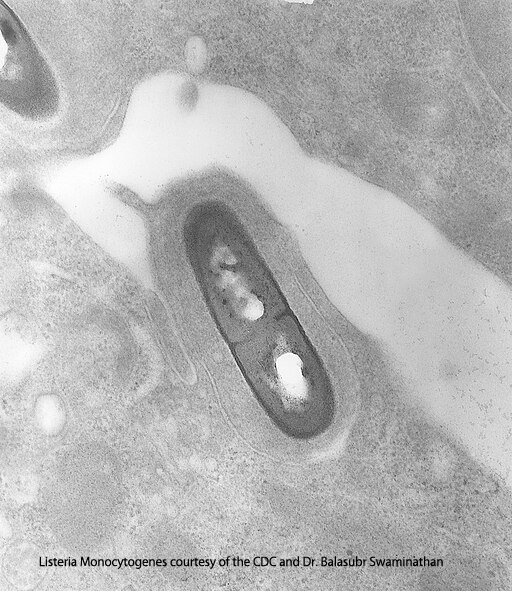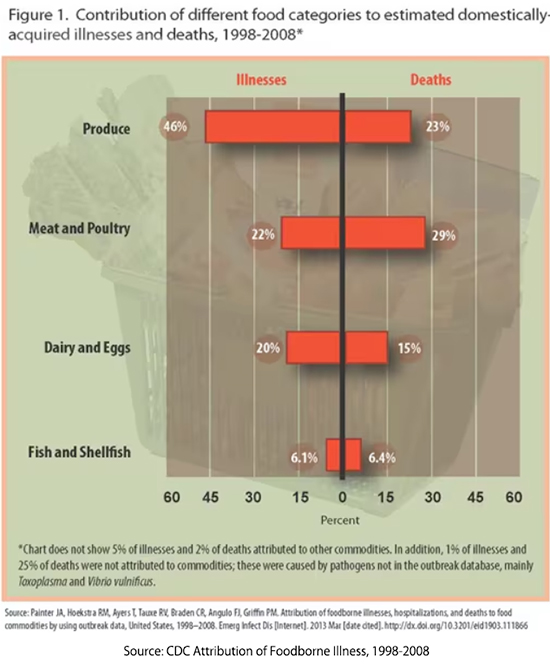
- On July 26, the CDC announced a food safety alert due to a Listeria outbreak linked to meats sliced at Delis.
- The FDA has announced a recall of guacamole and salsa products due to a risk of listeria contamination and some ice cream products.
- In 2015, Blue Bell ice cream was found to be contaminated by Listeria, resulting in ten cases of severe illness, including three deaths, putting Listeria at the top of the news cycle. Sanitation issues resulted in the contamination, and in 2020, Blue Bell was ordered to pay $17.25 million in criminal penalties, the largest ever following a food-safety case.
What is Listeria?
 Listeria are bacteria found in moist environments, including soil, water, decaying plants, and animal feces. They can contaminate food when harvested, prepared, packed, transported, stored, or directly through contaminated water or soil. People can develop a disease, listeriosis, from eating food contaminated with Listeria. Symptoms are usually mild but unpleasant, consisting of nausea, vomiting, and diarrhea. A rare but severe form of listeriosis, consisting of headache, stiff neck, confusion, loss of balance, convulsions, and death, can also occur. The very young, the elderly, pregnant women, and immune-compromised are most at risk for severe listeriosis.
Listeria are bacteria found in moist environments, including soil, water, decaying plants, and animal feces. They can contaminate food when harvested, prepared, packed, transported, stored, or directly through contaminated water or soil. People can develop a disease, listeriosis, from eating food contaminated with Listeria. Symptoms are usually mild but unpleasant, consisting of nausea, vomiting, and diarrhea. A rare but severe form of listeriosis, consisting of headache, stiff neck, confusion, loss of balance, convulsions, and death, can also occur. The very young, the elderly, pregnant women, and immune-compromised are most at risk for severe listeriosis.
Listeria is the third leading cause of food-related deaths in the US, causing an estimated 1,520 hospitalizations and 266 deaths in 2006. The actual number is probably much higher because many people do not see a physician or realize their illness is caused by food when they are sick.
Previous outbreaks of listeriosis have been linked to:
- Raw, unpasteurized milk and cheeses
- Raw or processed vegetables and fruits
- Raw or undercooked poultry
- Sausages, hot dogs, and cold cuts
- Raw or smoked fish.
The current food safety alert for deli meats results from an investigation into six illnesses and five hospitalizations, which found Listeria in an unopened package of liverwurst in Virginia. Investigators are looking into whether other meats, especially those sliced or prepared at the deli, are also contaminated since Listeria spreads easily among deli equipment, surfaces, hands, and food.
The only way to eliminateListeria in deli meats is to reheat it to a high enough temperature (165 degrees F) to kill the bacteria. Refrigeration will not kill the bacteria. However, I am not recommending reheating possibly contaminated deli meats – take them back to the store or throw them away.
The Bigger Picture
 The CDC estimates that one in six people in the US get foodborne illness in the US each year, resulting in 128,000 hospital stays and 3,000 deaths. With a population of 333 million, approximately 55 million people get sick every year! CDC data also shows increases in the number of reported multistate foodborne illness outbreaks (groups of two or more linked cases in multiple states) in recent years.
The CDC estimates that one in six people in the US get foodborne illness in the US each year, resulting in 128,000 hospital stays and 3,000 deaths. With a population of 333 million, approximately 55 million people get sick every year! CDC data also shows increases in the number of reported multistate foodborne illness outbreaks (groups of two or more linked cases in multiple states) in recent years.
Surprisingly, healthy foods, such as fruits and vegetables (produce), are responsible for about a quarter to a half of foodborne disease outbreaks, often caused by dirty processing equipment and unhygienic food preparation. Between 1973 and 2012, 85% of foodborne illnesses from leafy greens such as cabbage, kale, lettuce, and spinach were traced back to food prepared in restaurants or catering facilities. On the other side of the ledger, meat and poultry are responsible for the most food-related deaths.
Listeria is just one of many microbes that cause foodborne illness. It is not even the leading cause of foodborne illness or death in the US. That honor goes to Salmonella, a bacterium that caused an estimated number of 23,128 hospitalizations and 452 deaths in 2006. However, Salmonella is far less deadly than Listeria, with a mortality rate of 0.5% compared to Listeria’s 15.9% rate.
While different microbes cause foodborne illnesses than those responsible for water-borne diseases, two microbes that have caused serious illness in food and water.
- Campylobacter is a bacterium spread from animals, including chickens and cows, to people. It is very contagious; a single drop of juice from a contaminated chicken can cause illness. It can also be caused by improperly disinfected drinking water.
- Giardia: A parasite causing giardiasis, with symptoms of diarrhea, stomach cramps and pain, and dehydration. It causes more illness than any other parasite. While primarily from untreated drinking water from springs, lakes, or rivers, it can contaminate food.
All Americans should reasonably expect their food to be safe and not cause illness. Data indicates that foodborne illnesses decreased in 2020 and 2021 due to the pandemic but have returned to pre-pandemic levels in 2023. With approximately 55 million people getting sick each year from foodborne illnesses, there is more that the government and the private sector could do for food safety. The General Accountability Office (GAO) report on food safety recommended that the CDC publicize its decision-making process for communicating multistate outbreaks and establish an assessment system to evaluate its performance in dealing with these outbreaks.
However, a significant degree of protection from foodborne illness lies, literally, in our hands. Follow the simple rules your mother taught – beginning with washing your hands before and after handling food, cooking meat thoroughly, and, in the face of rising cases of avian influenza in our milk supply, not drinking unpasteurized milk.



